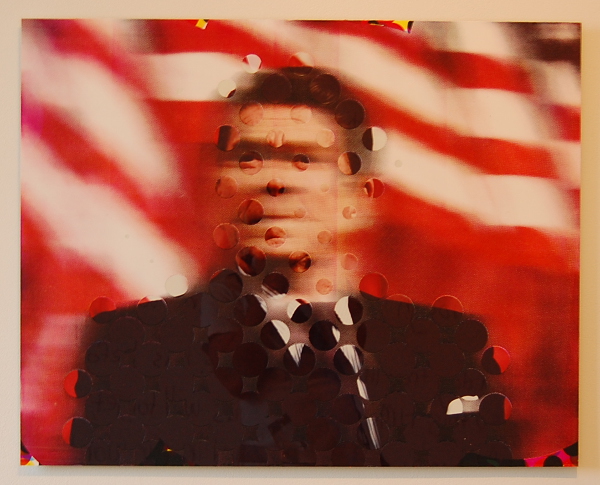
Marc Blumthal’s visage of America at Napoleon
Napoleon collective member Marc Blumthal has accosted the project space for the month of June with his show “The Flame and the Flower.” In the exhibit, Blumthal examines American culture by way of appropriated and altered images from Google. He dissects and skews these symbols so as to get closer to the desires and realities that reside in one of the most heterogeneous cultures the world has ever seen.
Marc Blumthal, “For Cause and Purpose (Edit of President George W. Bush’s Post-9/11 Address To The Nation).”
Towering over the tiny room is the largest piece by far: a text scrawled onto the wall that stretches nearly from floor to ceiling like a gigantic public journal entry. “For Cause and Purpose (Edit of President George W. Bush’s Post-9/11 Address To The Nation)” stands as a testament to the bold and sweeping rhetoric that politicians utilize to sway the masses. Oftentimes both a display of power and an appeal to familiarity, such speeches serve to satiate listeners with what they want to hear as well as assert dominance. Blumthal chose to chop up and reorganize one of the most pivotal speeches in recent history – the one marking the beginning of the post-9/11 world. Here, George W. Bush’s words seem nonsensical and incomplete, twisted out of context and shortened by the artist. Strangely enough, many of the concepts remain intact enough to decipher the gist of the address. This phenomenon seems to question exactly how much meaning the text actually contained to begin with, or even our perception of such topics.
Marc Blumthal, “Punching a Common Mistake (Mark Blumenthal) In The Face.”
One of the most amusing works here is entitled “Punching a Common Mistake (Mark Blumenthal) In The Face.” Clearly, with a name like ‘Marc Blumthal,’ the artist must encounter a great many misinterpretations of his name and the parenthetical segment of the title provides an example. Having Google-searched his doppelgänger, Blumthal printed the imposter’s face on a sheet of aluminum and subsequently punched (or otherwise smashed) in the front of the image in a show of protest and frustration. Although the Internet provides us with a never-ending stream of information, it also allows for the unpleasant possibilities of stalking, mistaken identity, or a general lack of privacy, among others. Individuality may be important to the American spirit, but in a sea of names, it can be easy to feel swallowed up.
Marc Blumthal, “Crystal.”
On a centrally located pedestal, a tiny, glass, cube-like form stands on its flattened corner. This paperweight of a sculpture contains the eerily realistic etching of a woman. Entitled “Crystal,” one can assume the pictured figure may bear this name. Being etched into glass, the visual pun is evident. As a simple homage to a woman that likely zero visitors to Napoleon will know, it acts as a fun counterweight to the punched aluminum Mark.
Marc Blumthal, “Untitled Mask.”
Blumthal also includes a family photo and a picture of Ronald Reagan each mottled with overlapping circles and pixels, reducing their quality and melding them into art instead of documentation. While their original images are discernible, they take on qualities of otherness and unease which are both intriguing and somewhat alienating.
Marc Blumthal’s “The Flame and the Flower” will be on display at Napoleon through June 28.
Napoleon is located at 319 N. 11th St., 2L on the second floor, Philadelphia; [email protected]; napoleonnapoleon.com.
Recent Content
-
Artsarticle ·
-
Artsarticle ·
-
Artsarticle ·




